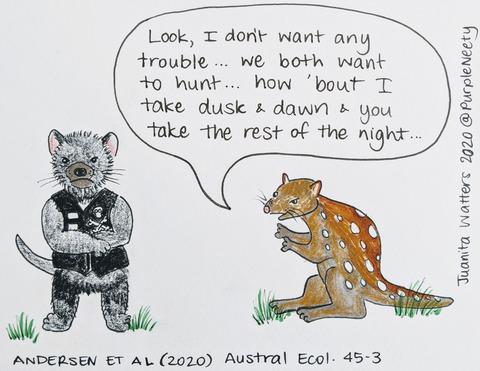当前位置:
X-MOL 学术
›
Austral Ecol.
›
论文详情
Our official English website, www.x-mol.net, welcomes your feedback! (Note: you will need to create a separate account there.)
Space use and temporal partitioning of sympatric Tasmanian devils and spotted-tailed quolls
Austral Ecology ( IF 1.5 ) Pub Date : 2020-03-18 , DOI: 10.1111/aec.12865 Georgina E. Andersen 1 , Christopher N. Johnson 1, 2 , Menna E. Jones 1
Austral Ecology ( IF 1.5 ) Pub Date : 2020-03-18 , DOI: 10.1111/aec.12865 Georgina E. Andersen 1 , Christopher N. Johnson 1, 2 , Menna E. Jones 1
Affiliation

|
Sympatric species can minimise interspecific competition by spatial avoidance or by altering their temporal activity to reduce encounter rates. The Tasmanian devil (Sarcophilus harrisii), the largest carnivorous marsupial, coexists with the smaller spotted‐tailed quoll (Dasyurus maculatus) in Tasmania, Australia. Quolls may be susceptible to interspecific competition from devils, because they utilise similar habitats, consume similar prey species and are displaced by devils at food sources. Such competition might cause quolls to spatially or temporally avoid devils. To investigate whether spatial or temporal avoidance occurred, we deployed GPS collars on sympatric devils and quolls and conducted a camera survey at a site in northwest Tasmania where the devil population was not affected by devil facial tumour disease. GPS tracking coincided with the lactation period when devils and quolls had young in dens and continued until weaning occurred. We found little spatial segregation of home range and core area placement between devils and quolls and among devils. Quolls showed more spatial segregation within the sexes than between them. Devils had larger home ranges than quolls. Male devils had larger home ranges than females, but there was no difference in home range size between the sexes of quolls. Females of both species travelled significantly further per night than did males. There was moderate temporal partitioning between the two species: devil activity peaked after dusk and devils remained active until the early morning, while quoll activity showed distinct peaks around dusk and dawn. In conclusion, quolls did not spatially avoid devils but moderate temporal partitioning occurred. It is plausible that quolls are active at different times of the diel cycle to reduce encountering devils, but further studies are needed to resolve the cause of this temporal partitioning.
中文翻译:

同域袋獾和斑尾袋鼬的空间利用和时间划分
同域物种可以通过空间回避或通过改变它们的时间活动以降低遭遇率来最小化种间竞争。袋獾 (Sarcophilus harrisii) 是最大的食肉有袋动物,在澳大利亚塔斯马尼亚与较小的斑尾袋鼬 (Dasyurus maculatus) 共存。袋鼬可能容易受到来自魔鬼的种间竞争的影响,因为它们利用相似的栖息地,消耗相似的猎物物种,并且在食物来源上被魔鬼取代。这种竞争可能会导致袋鼬在空间或时间上避开魔鬼。为了调查是否发生了空间或时间回避,我们在同域魔鬼和袋鼬身上部署了 GPS 项圈,并在塔斯马尼亚西北部的一个地点进行了相机调查,那里的魔鬼种群不受魔鬼面部肿瘤疾病的影响。GPS 跟踪与魔鬼和袋鼬在巢穴中幼崽的哺乳期相吻合,并一直持续到断奶。我们发现魔鬼和袋鼬之间以及魔鬼之间的家庭范围和核心区域放置的空间隔离很小。袋鼬在两性之间表现出比它们之间更多的空间隔离。魔鬼的栖息地比袋鼬大。雄性袋獾比雌性有更大的活动范围,但袋鼬的雌性间活动范围大小没有差异。这两种物种的雌性每晚比雄性走得更远。两个物种之间存在适度的时间划分:魔鬼活动在黄昏后达到顶峰,魔鬼一直活跃到清晨,而袋鼬活动在黄昏和黎明前后表现出明显的高峰。综上所述,袋鼬并没有在空间上避开魔鬼,但发生了适度的时间分区。有可能袋鼬在昼夜循环的不同时间活跃以减少遇到魔鬼,但需要进一步的研究来解决这种时间划分的原因。
更新日期:2020-03-18
中文翻译:

同域袋獾和斑尾袋鼬的空间利用和时间划分
同域物种可以通过空间回避或通过改变它们的时间活动以降低遭遇率来最小化种间竞争。袋獾 (Sarcophilus harrisii) 是最大的食肉有袋动物,在澳大利亚塔斯马尼亚与较小的斑尾袋鼬 (Dasyurus maculatus) 共存。袋鼬可能容易受到来自魔鬼的种间竞争的影响,因为它们利用相似的栖息地,消耗相似的猎物物种,并且在食物来源上被魔鬼取代。这种竞争可能会导致袋鼬在空间或时间上避开魔鬼。为了调查是否发生了空间或时间回避,我们在同域魔鬼和袋鼬身上部署了 GPS 项圈,并在塔斯马尼亚西北部的一个地点进行了相机调查,那里的魔鬼种群不受魔鬼面部肿瘤疾病的影响。GPS 跟踪与魔鬼和袋鼬在巢穴中幼崽的哺乳期相吻合,并一直持续到断奶。我们发现魔鬼和袋鼬之间以及魔鬼之间的家庭范围和核心区域放置的空间隔离很小。袋鼬在两性之间表现出比它们之间更多的空间隔离。魔鬼的栖息地比袋鼬大。雄性袋獾比雌性有更大的活动范围,但袋鼬的雌性间活动范围大小没有差异。这两种物种的雌性每晚比雄性走得更远。两个物种之间存在适度的时间划分:魔鬼活动在黄昏后达到顶峰,魔鬼一直活跃到清晨,而袋鼬活动在黄昏和黎明前后表现出明显的高峰。综上所述,袋鼬并没有在空间上避开魔鬼,但发生了适度的时间分区。有可能袋鼬在昼夜循环的不同时间活跃以减少遇到魔鬼,但需要进一步的研究来解决这种时间划分的原因。


























 京公网安备 11010802027423号
京公网安备 11010802027423号